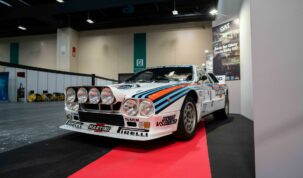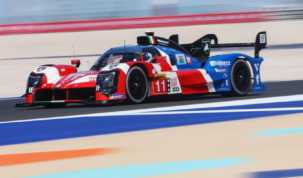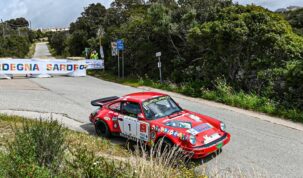FOUR ‘RACING LANCER’ WILL SPEARHEAD MITSUBISHI’S BID TO CLAIM HISTORIC WIN WITH DIESEL POWER ON 2009 DAKAR
Mitsubishi Motors Corporation and its motor sport unit, the Repsol Mitsubishi Ralliart team, in association with its partners Repsol, Valeo and BFGoodrich – will enter the new, turbodiesel ‘Racing Lancer’ in next year’s Dakar Rally which will take competitors through Argentina and Chile from Saturday January 3 until Sunday January 18, 2009.
The Repsol Mitsubishi Ralliart team is poised to kick off its first full season using turbocharged diesel power with a four-car entry on the 2009 Dakar. The team’s bid will be spearheaded by its latest cross-country rally car, the new Racing Lancer. 
The four-car driver line-up is the same as that which has represented the team on this annual cross-country rally since 2005, namely Stéphane Peterhansel (France), Hiroshi Masuoka (Japan), Luc Alphand (France), and Joan ‘Nani’ Roma (Spain).
The 31st Dakar Rally will see the event switch to fresh territory in South America where Mitsubishi’s foursome will be looking to secure not only its first-ever victory with a diesel powered car, but also the company’s 13th success – including a run of seven successive wins since 2001- at this event.
The Racing Lancer will be officially unveiled on Thursday October 2 at the 2008 Paris Motor Show (Paris Expo, Paris, France) which opens to the public from Saturday, October 4 until Sunday, October 19. It will be displayed alongside the ‘Lancer Sportback’ upon which it is based and which is due to go on sale across Europe this autumn.
The 2009 Dakar
Following deterioration in the security situation in West Africa, which has traditionally served as backdrop to the Dakar, the event organisers have chosen to switch to the South American continent for next year’s event.
The 2009 rally is due to start in the Argentine capital Buenos Aires on Saturday, January 3 before striking south to the South Atlantic resort of Puerto Madrine. The route will then head west over the dusty trails up and over the Andes Mountains.
Competitors will benefit from a rest day in the historic Chilean Pacific port of Valparaiso on Saturday January 10, with competition resuming the following day, taking them north to the Atacama Desert, then back across the Andes and into Argentina again. After a stopover in Argentina’s second-biggest city, Cordoba, the 9,000km loop will end with the official finish in Buenos Aires on Sunday January 18.
Although precise details of the itinerary have yet to be released, the total stage distance is expected to amount to approximately 6,000km, with non-paved surfaces – including sand – accounting for 90 per cent of this figure.
The maximum number of entries has been set at 560, including 275 motorbikes and quads, 200 cars and 85 trucks. 
Repsol Mitsubishi Ralliart Team
The Repsol Mitsubishi Ralliart team is directed by Dominique Serieys (France), himself a previous Dakar winner with the Mitsubishi Pajero/Montero as a co-driver in 1993. The technical side of the operation is directed Thierry Viardot (France) with the support of engineers from Mitsubishi Motors.
Efficient organisation can make the difference between victory and defeat on the Dakar. The Repsol Mitsubishi Ralliart team’s logistical operation – which includes looking after the movements and needs of the team’s 15 vehicles and 65 staff members – is the responsibility of David Serieys (France).
Two T4 6×6 vehicles carrying mechanics, tires, and spare parts plus equipment will follow the same itinerary as the competitors, ready to intervene should one of the four Racing Lancers encounter a problem. In addition to the race trucks, the team’s fleet consists of 8 SUVs for the transport of personnel and management staff, 5 T5 trucks also carrying tires, spare parts and equipment. These vehicles follow via an alternative route.
Two of these SUVs will be cross-country ‘Pajero Sport’ models, which is due to go on sale, this autumn, across the ASEAN nations, the Middle East, Central America, Oceania, and Russia.
The Repsol Mitsubishi Ralliart team’s line-up for the 2009 Dakar is Luc Alphand/Gilles Picard (France), Hiroshi Masuoka/Pascal Maimon (Japan/France), Stéphane Peterhansel/Jean-Paul Cottret (France) and Joan ‘Nani’ Roma/Lucas Cruz (Spain).
Luc Alphand took up motor sport following a glittering career in Alpine skiing which saw him win the 1997 World Cup. He made his Dakar debut in 1998 and joined Mitsubishi in 2004, winning the event outright two years later in 2006 with Pajero/Montero Evolution.
Hiroshi Masuoka took wins in the Production class on the 1990 and 1994 Dakar events before making the move up to the discipline’s premier category in 2000. He took successive outright wins on the event with the Pajero and the Pajero/Montero Evolution in 2002 and 2003.
After securing six Dakar wins on motorbikes, Stéphane Peterhansel switched to four-wheelers in 1999 and joined Mitsubishi in 2002. Driving the Pajero/Montero Evolution, he added three further Dakar successes to his record in 2004, 2005 and 2007, earning himself the nickname ‘Monsieur Dakar’. 
Like Peterhansel, Joan ‘Nani’ Roma came to four-wheel competition after a successful career on motorbikes. He was the European Enduro Champion in 1994 and first contested the Dakar in 1996. After winning the motorbike category outright in 2004, he switched to four wheels the following year, competing in a Mitsubishi. A year later, he took part in the 2006 Dakar as part of the works squad and finished third in his Pajero/Montero Evolution.
The new Mitsubishi ‘Racing Lancer’
The motor sport department of Mitsubishi Motors and MMSP both contributed to the development of the Racing Lancer which complies with the Group T1 regulations of the FIA (motor sport’s international governing body: Fédération Internationale de l’Automobile) introduced in 2002. The firm’s latest cross-country rally car, which has been designed to take onboard the new super production regulations when they come into force in 2010, has benefited extensively from the experience acquired with the Pajero/Montero Evolution.
The development of the turbo-diesel engine began in April 2006 before being grafted into a Pajero/Montero Evolution for testing purposes in June 2007. Development of the body began in August 2007 and the first Racing Lancer was completed in June 2008. This car was put through its paces during one-week test sessions in Spain and Morocco, as well as over typical cross-country rally terrain in France. Based on the data collected during these tests, further sessions were organized in Morocco at the end of August/early September plus another two weeks in October prior to the Racing Lancer’s debut on the sixth round of the FIA Cross-Country Baja International Cup, the Baja Portalegre (Thursday, October 30 to Sunday, November 2).
The Racing Lancer is based on a new multi-tubular steel frame. The team has taken particular care to minimize weight, while the additional space freed up by the longer wheelbase – a decision based on the regulations due to come into force in 2010 – has enabled the gas tank to be positioned lower in the car and has consequently brought down the centre of gravity. Handling has also been improved thanks to the new location of the spare tires which ensures enhanced control of the moment of inertia.
Mitsubishi Motors’ design department was responsible for the body styling which uses carbon panels based on the design of the Lancer Sportback. The design was finalized after validation of the new car’s aerodynamic performance in a wind tunnel.
The powerful 3-liter V6 diesel engine features a two-stage turbocharger which positions a small and large turbine configuration on each side of engine, working with both the small and large turbine according to engine revolution and load.
Peak torque is 66.3kgfm (650Nm), while maximum power currently stands at 280PS (206kW), although this figure is expected to increase as development work continues. The cooling system of the intercooler is positioned at the rear of the car and is fed by the characteristic roof-mounted air scoop.
The V6 engine is fed through a manual Ricardo five-speed sequential gearbox engineered to cope with the high torque delivered by the powerplant. The Racing Lancer’s permanent four-wheel drive transmission features the same self-locking differential as that used for Pajero/Montero Evolution.
Both the front and rear suspension systems feature extensively revised geometry and are both based on a double wishbone layout with coil springs, anti-roll bars and uprated BOS dampers which can be adjusted through a broader range. The car runs on BFGoodrich’s new low-energy 245/80-16 cross-country rally tires and OZ aluminum alloy wheels (16x7JJ). The vented 16-inch brake discs are coupled with six-piston Brembo calipers. 
Please find below an amended specification for the Mitsubishi Racing Lancer
Racing Lancer Specifications:
OVERALL LENGTH…………….4475mm
OVERALL WIDTH………………1990mm
WHEELBASE……………………..2900mm
FRONT/ REAR TRACK……….1750mm/1750mm
OVERALL WEIGHT…………….1900kg
ENGINE MODEL…………………6-cylinder Turbodiesel 24-Valve with dry-sump oil system
FUEL SYSTEM…………………..Common rail high pressure injection
DISPLACEMENT………………..2997cc
MAXIMUM OUTPUT…………..206kw (280 PS), 650Nm (66.3 kgfm)
FUEL TANK CAPACITY……….TBA
TRANSMISSION…………………5-speed ‘Ricardo’-type, sequential shift gearbox and mechanical gear selection
4WD SYSTEM……………………full time, mechanical center diff lock
FRONT DIFF………………….’Ricardo’ self-locking differential
REAR DIFF……………………’Ricardo’ self-locking differential
SUSPENSION
FRONT………………………Independent, double wishbones, coil spring
REAR……………………….Independent, double wishbones, coil spring and anti-roll bar system
DAMPERS……………………’BOS’ fully-adjustable damping
WHEEL STROKE……………….250 mm front and rear
STEERING…………………..Power-assisted rack and pinion
BRAKES……………………’BREMBO’ Front and rear Ventilated discs with 6-piston calipers
WHEELS……………………’OZ’ aluminum (7JJ x 16)
TIRES…………………………BF Goodrich (245/80 – 16)
OTHERS……………………Aeronautic steel multi-tubular frame, Honeycomb body floor and carbon fiber body
Measures in favour of the environment
Team Repsol Mitsubishi Ralliart will be taking a range of measures to reduce its environmental impact for the 2009 Dakar.
The competing Racing Lancers will feature advanced diesel technology, including high pressure injection and low compression ratios. The cars will run on a fuel mix that includes biodiesel*1, a carbon-neutral*2 alternative fuel, while green plastic*3 has been employed for several components including high frequency consumption parts as front bumper corners, mud guards, etc.
Repsol sees the arrival of diesel power for the Racing Lancer as an ideal opportunity to bring its latest research developments into efficient fuels in general and non-food sourced biodiesel in particular to the table. The Spanish-based oil and gas firm’s efforts in this field contributed to its recent nomination as a ‘Gold Class’ company in the Sustainability Yearbook 2008 compiled by Pricewaterhouse Coopers and Sustainable Asset Management (SAM), an independent company tasked with conducting the annual assessments for the Dow Jones Sustainability Index.
Valeo green technologies’ experience of automotive systems and electronics proved invaluable during the development of the ‘Racing Lancer’s’ cooling system which uses the UltimateCooling architecture. Valeo’s input also concerned the LED daytime running lights, rear lights and roof-mounted stop light which are more efficient since producing less heat, consume significantly less energy – and therefore less fuel – and are longer lasting.
MMSP will benefit from the latest BFGoodrich-developed ”All Terrain” tire (245/80-16) which boasts both versatility and durability. It is ideal for the sort of mixed, hostile terrain and long competitive distances found in cross-country rallying in general and on the 2009 Dakar in particular. The BFGoodrich’s ”All Terrain” ‘s characteristics and new dimension ensure low rolling resistance, as well as a more comfortable ride. It also stronger with a view to shrugging off the risk of punctures.
(*1) Biodiesel: an alternative fuel made using vegetable matter (non-food vegetable matter in this case).
(*2) Carbon neutral: total carbon dioxide emissions across the full lifecycle are offset by carbon dioxide absorbed during the production process. In the case of biofuel, vegetable matter absorbs CO2 through photosynthesis as it grows.
(*3) Green plastic: carbon-neutral vegetable-based resins employed instead of oil-based resins.




